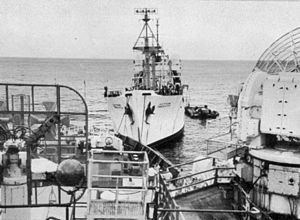Name USNS Timber Hitch Completed January 1945 Length 103 m Tons burthen 5.525 million kg | Namesake A name retained Launched 12 October 1944 Tonnage 3.054 million kg | |
 | ||
Laid down date unknown, as a type (C1-M-AV1) hull, MC hull 2466 Acquired by the U.S. Navy in 1964 In service c. 1958 as a missile tracker Builder Consolidated Steel Corporation | ||
USNS Timber Hitch (T-AGM-17) was a U.S. Navy missile range instrumentation ship which earlier operated as the U.S. Air Force Ocean Range Vessel USAFS Timber Hitch (ORV-17) on the U.S. Air Force's Eastern Test Range during the late 1950s and early 1960s. Timber Hitch operated under an Air Force contract with Pan American Airways Guided Missile Range Division headquartered in Cocoa Beach, Florida.
Contents
Timber Hitch, assigned to the South Atlantic Ocean and the Caribbean area, provided the Air Force with metric data on intercontinental ballistic missiles launched from the Cape Canaveral Air Force Station (CCAFS) in Florida.
Timber Hitch operated in the intercontinental ballistic missile re-entry area near Ascension Island, and was home-ported out of Recife, Brazil.
Acquisition by the Navy
Timber Hitch was acquired from the U.S. Air Force by the U.S. Navy in 1964.
Operational data
Operational data while on U.S. Navy service during post-1964 period on this vessel is lacking.
Inactivation
Timber Hitch was struck from the Navy List 9 October 1969, and was scrapped by MARAD, 27 July 1977. Her subsequent fate is not known.
